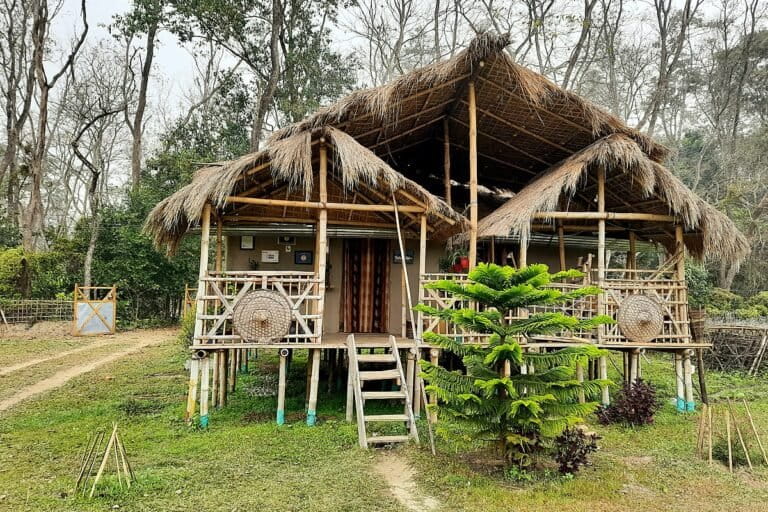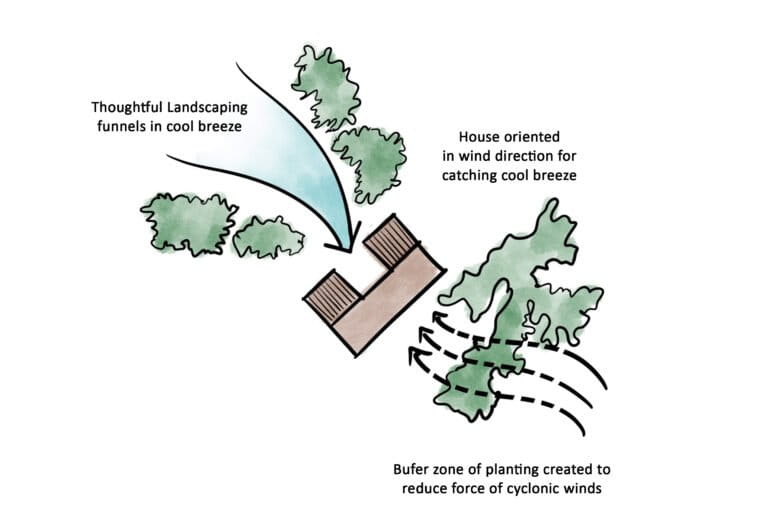- Sensitive and thoughtful design of the built environment of cyclone vulnerable communities is imperative to reduce impacts and build resilience.
- Principles of frangible architecture or architecture that ‘plans for damage’ helps in designing the built and unbuilt environments of communities for resilience against cyclonic events, writes the author of this commentary.
- A collaborative approach that integrates inclusive policies, socio-economic infrastructure, institutional partnerships and addresses vulnerability and preparedness to response and recovery, builds a sustainable model for disaster resilience in the long run.
- The views in this commentary are that of the author.
Cyclone Biparjoy swept across the Arabian Sea in June 2023, hitting the coasts of Gujarat and Pakistan, causing extensive loss and destruction. The incident reignited discussions about the impact of cyclones and the pressing need for resilience. Cyclone-prone areas around the world suffer loss of life, livestock and property every time a cyclone hits. The aftermath points to the fact that a lack of infrastructural preparedness coupled with poorly designed community environments are the reasons for exacerbating impacts. A large part of building disaster resilience to cyclones within coastal communities comes with a thoughtful approach to design and planning of the built environment.

Risk versus vulnerability to cyclones
Risks are not natural but perceived and posed by human intervention. For instance, the risk of communities planned in areas that were naturally prone to flooding is posed because of the human intervention of building in such a sensitive area. The vulnerability of a community to handle natural disasters is determined by its adaptive capacity to catastrophe. This capacity is a mix of social, economic, environmental and infrastructural factors. The better a community’s resilience to resisting cyclones, the better it will cope in the event of one.

Cyclone vulnerability of the Indian subcontinent
Vulnerability assessment is crucial for avoiding impact. We cannot negate the fact that India was among the top 10 climate change-affected countries in the world according to the Global Climate Risk Index 2021. The country has coastlines stretching to 8041 kilometres that are prone to almost 10% of the world’s tropical cyclones.
While the systems of governance are in place, with bodies at the helm of disaster management in India, such as the National Disaster Management Authority (NDMA), National Disaster Response Force (NDRF) and Coalition for Disaster Resilient Infrastructure (CDRI) , there still lies a need to embed awareness and build capacities of communities in terms of cyclone resilience and impact mitigation.
This brings us to pressing questions of implementation – how can the built environment build resilience towards cyclones through sustainable strategies for risk mitigation?
Design and strategy for cyclone risk mitigation
Frangible architecture or architecture that ‘plans for damage’ refers to the thoughtful design of every element of the built and unbuilt to make it resilient in the face of strong winds, flooding and other extreme climatic events. Following the principles of this approach will minimise or even attenuate the damage caused in the event of a natural disaster and in turn protect human and non-human lives.
Architectural form-finding in indigenous techniques is one part of this approach. India’s traditional knowledge systems made intuitive use of cyclone-resistant forms embedded in the vernacular knowledge systems. Both, the Bhunga huts in Kutch and Chuttillu houses in Andhra Pradesh, for example, were traditionally built in circular layouts for effective cyclone and earthquake resistance. Circular and domical forms help reduce the force of cyclonic winds, thus preventing the structure from uprooting.

Emulating nature-based design, just as the tree is heaviest at the bottom, receding and becoming light as it rises above, similarly, a building with lighter superstructures using materials like bamboo or wood, must have heavy foundations. Having a stable foundation with strong connections with the superstructure will resist the uplift forces of wind and prevent the building from uprooting and blowing over with the cyclone. Cyclones are often followed by intense showers and flooding. To counter that, homes in coastal areas can also become adaptive by being raised on stilts to allow flood water to pass through without damaging the dwelling, as seen in traditional dwellings of Assam. Traditional Indigenous solutions that have been developed and passed on from generations to build disaster resilience must be learnt, imbibed and re-introduced.

There is a common misconception that masonry houses are safe in the event of cyclones. But roof damage can easily make these seemingly resilient houses vulnerable to intensive damage. The roof design must cater to the thumb rules of frangible architecture to make sure they are not swept off with powerful gusts. Roofs must be designed such that they are broken into multiple parts with slopes at different levels, thereby avoiding a singular large roof above the entire dwelling. This will make sure that only the roofs covering verandas/porches blow off during a cyclone, thus preventing structural damage to the main dwelling and protecting the inhabitants.

Cyclones are inevitably followed by heavy showers and flooding. With reducing green cover and increased concretization, the ability of the earth to absorb excessive rainwater has reduced tremendously, especially in urban areas. It is crucial to restore floodplain ecosystems that become sponges to improve porosity, thereby allowing floodwaters to percolate into the ground, easing out surfaces and ultimately regenerating groundwater tables in the bid. This will also solve acute water problems in dense urban areas.

Even though there may be certain thumb rules of designing for resilience, the larger setting and context plays a pivotal role in determining specific site-based solutions. The terrain- whether steep hill slopes or soft floodplains; decisions of planting indigenous species to restore local ecosystems; usage of local building materials and replenishment of these resources to protect local ecologies etc. must be accounted for on site. Siting of buildings plays an important role in combating cyclonic winds. Orientation of dwellings and pointed landscape strategies as per local wind patterns becomes paramount to minimise damage. Mangroves and indigenous plant species close to the coastal belt help mitigate wind speed and hence, these ecosystems must be preserved and restored.

UNEP’s A Practical Guide to Climate-resilient Buildings & Communities is a comprehensive report on building resilient infrastructure in developing countries that are prone to disasters, which also includes frangible measures of building infrastructural resilience.
Post disaster reconstruction
Precaution is definitely better than care when it comes to resilience. But vulnerable communities must also reserve enough bandwidth for post disaster reconstruction measures. The United Nations Office for Disaster Risk Reduction (UNDRR) looks into providing support to high-risk areas around the world for building capacities and resilience. UNDRR’s vision stems from the Sendai Framework and the four priorities viz. Understanding disaster risk, strengthening risk governance, investing in disaster risk reduction for resilience, boosting preparedness for a strong response, and “Build Back Better” in recovery, rehabilitation and reconstruction for coping post-disaster. Reconstruction must follow participatory owner-driven approaches to work toward frangible adaptations to restore dwellings as more resilient than before.
Need for a holistic approach
Disasters are not stand-alone but cascade and compound with a chain of events. Cyclones too are not isolated phenomena, but a result of related environmental issues. To tackle risks posed by one disaster, all other vulnerabilities must be understood and tackled in an interconnected manner. Addressing vulnerabilities of cyclone-prone communities and building resilience is in adherence to the UN’s 11th Sustainable Development Goal– Sustainable cities and communities. Building resilience of cyclone-prone communities needs a more holistic lens that foresees interconnected issues and hence integrates inclusive policies, strong socio-economic infrastructure, institutional partnerships and robust measures to address vulnerability and preparedness for response and recovery. A collaborative approach will prove to be sustainable and resilient in the long run.
CITATION:
- 5 ways to make buildings climate change resilient. (n.d.). UNEP. https://www.unep.org/fr/node/29710
- Arya, A., & Agarwal, A. (2007). Cyclone resistant building architecture. Government of India-United Nations Development Programme (UNDP) Disaster Risk Management Programme.
- Cyclone | NDMA, GoI. (n.d.). https://ndma.gov.in/Natural-Hazards/Cyclone
- Tikoo, R. (2021, July 12). Promoting construction of climate-resilient buildings among communities at risk. Times of India Blog. https://timesofindia.indiatimes.com/blogs/development-chaupal/promoting-construction-of-climate-resilient-buildings-among-communities-at-risk/
- 2022: A year when disasters compounded and cascaded (2023) Coalition for Disaster Resilient Infrastructure. Available at: https://www.cdri.world/blogs/2022-a-year-when-disasters-compounded-and-cascaded (Accessed: September 2023).
- United Nations Environment Programme (2021). A Practical Guide to Climate-resilient Buildings & Communities. Nairobi.
- Trundle, A., & McEvoy, D. (2016). Honiara urban resilience and climate change: A joint strategy for the Honiara City Council and the Solomon Islands Government.
- Reardon, C. and D. Clarke. Passive design: Passive cooling. Passive Design 2013. https://www.yourhome.gov.au/passive-design/passive-cooling
The author is an independent architectural writer based in Pune, India.
Banner image: Impacts following cyclone Amphan in Kolkata. Photo by Indrajit Das/Wikimedia Commons.
